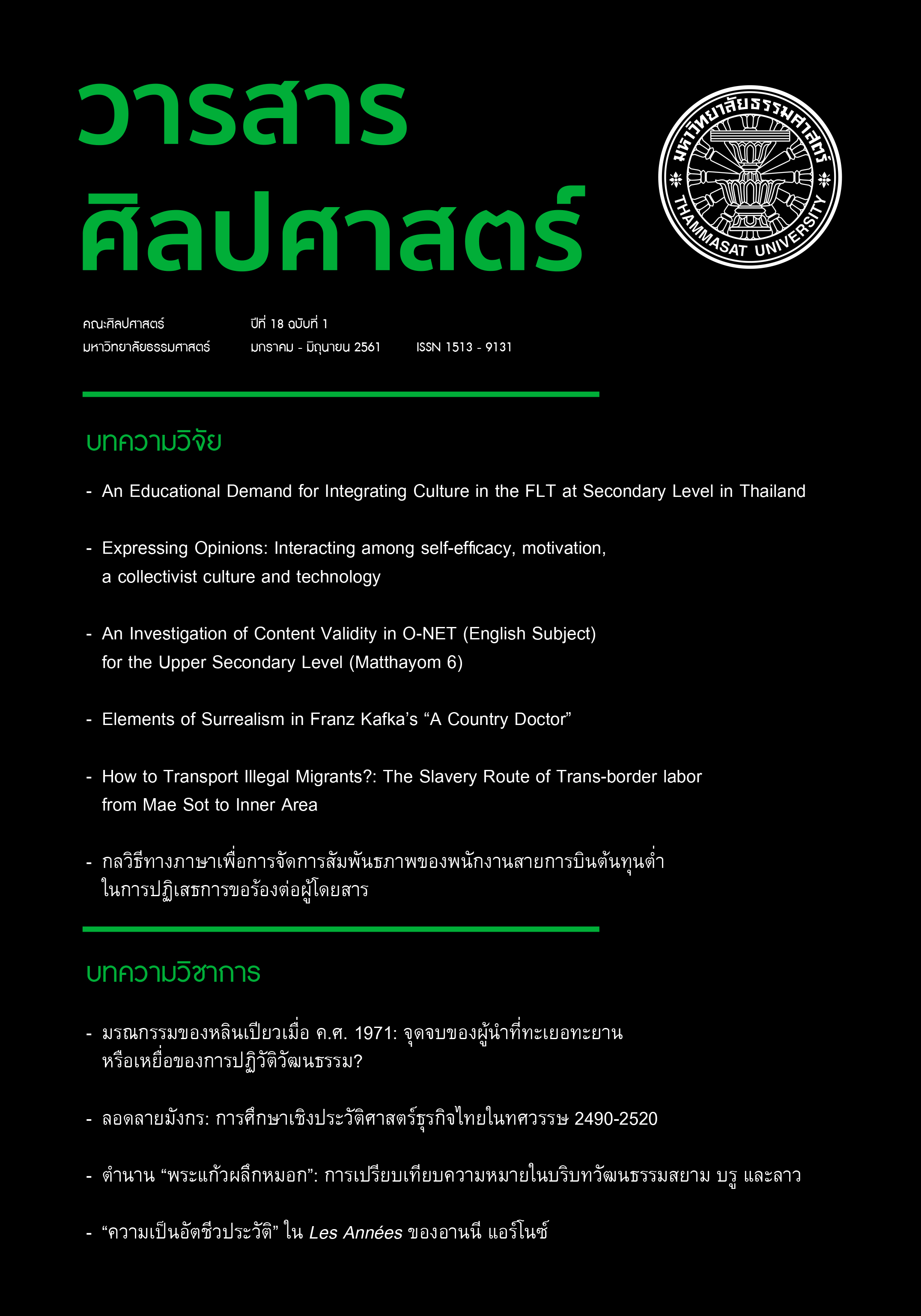ความต้องการในการบูรณาการเนื้อหาเกี่ยวกับวัฒนธรรมในรายวิชาภาษาอังกฤษระดับมัธยมศึกษาตอนต้นของประเทศไทย
Main Article Content
บทคัดย่อ
บทความวิจัยฉบับนี้มีวัตถุประสงค์ที่จะวิเคราะห์หลักสูตรแกนกลางการศึกษาขั้นพื้นฐาน ปีพุทธศักราช 2551 เพื่อเป็นแนวทางในการบูรณาการการสอนภาษากับวัฒนธรรมในการพัฒนาทักษะการสื่อสารข้ามวัฒนธรรมในบริบทของประเทศไทย บทความวิจัยฉบับนี้อภิปรายในสองประเด็นหลักคือการสอดแทรกเนื้อหา และแหล่งความรู้ทางวัฒนธรรมในการสอนภาษาเพื่อพัฒนาทักษะการสื่อสารข้ามวัฒนธรรม ในระดับมัธยมศึกษาตอนต้น และสรุปประเด็นสำคัญโดยการแนะนำแนวทางในการพัฒนาทักษะการสื่อสารข้ามวัฒนธรรมให้กับเด็กไทย เพื่อเตรียมตัวเข้าสู่ประชาคมอาเซียนและประชาคมโลก
Downloads
Article Details

อนุญาตภายใต้เงื่อนไข Creative Commons Attribution-NonCommercial-NoDerivatives 4.0 International License.
เอกสารอ้างอิง
Banu, I. U. D. (2015). Intercultural visual language and visual communication difference. European Academic Research, 3(12), 15252-15263. Retrieved from http://euacademic.org/UploadArticle/1448.pdf
Beamer, L., & Varner, I. (2008). International communication in the global workplace. NY: McGraw-Hill.
Byram, M. (1997). Teaching and assessing intercultural communicative competence. Clevedon, Great Britain: Multilingual Matters.
______. (2009). The intercultural speaker and the pedagogy of foreign language education. In D. K. Deardorff (Ed.), The Sage handbook of intercultural competence (pp. 321-332). Thousand Oaks, CA: Sage.
Cheng, L. L. (2007). Cultural intelligence: A quest for cultural competence. Communication Disorders Quarterly, 29, 36-42.
Cortazzi, M., & Jin, L. (1999). Cultural mirrors materials and method in the EFL classroom, in E. Hinkel (Ed.), Culture in second language teaching and learning. Cambridge: Cambridge University Press.
Council of Europe. (2001). Common European Framework of Reference for Languages: Learning teaching assessment, Council of Europe, Modern Languages Division.Starbourg and Cambridge: Cambridge University Press.
Kachru, B. B. (1997). World Englishes and English-using communities. Annual Review of Applied Linguistics, 17, 66-87.
Kitao, K. (2000). Teaching culture in foreign language instruction in the United States. Retrieved from: http://www1.doshisha.ac.jp/~kkitao/library/article/culture.htm.
Kramsch, C. (1998). The cultural discourse of foreign language textbooks. In J. Singerman (Ed.), Toward a new integration of language and culture. Northeast Conference Reports (pp. 63-88). Middle bury: Vermont.
Liddicoat, A. J. (2002). Static and dynamic views of culture and intercultural language acquisition. Babel, 36(3), 4-11.
Lund, R. (2006). Questions of culture and context in English language textbooks: A study of textbooks for the teaching of English in Norway (Doctoral dissertation). University of Bergen, Norway.
McKay, S. L. (2003). The cultural basis of teaching English as an international language. Retrieved from http://elt.britcoun.org/pubs/articles/2003/tm13-4-01.htm
McKay, S. L. (2003b). Toward an appropriate EIL pedagogy: Re-examining common ELT assumptions. International Journal of Applied Linguistics, 13(1), 1-22.
Ministry of Education [MOE]. 2008. The basic education core curriculum. Retrieved from http://www.act.ac.th/document/1741.pdf
Schoenmakers, H. (2012). The power of culture: A short history of Anthropological theory about culture and power. Retrieved from http://philosophy.uchicago.edu/faculty/files/forster/Herderslmportance.pdf
Schreier, M. (2012). Qualitative content analysis in practice. Thousand Oaks, CA: Sage.
Scollon, S. (1999). Not to waste words or students: Confucian and Socratic discourse in the tertiary classroom. In Eli Hinkel (Ed.), Culture in Second Language Teaching and Learning. Cambridge, UK: Cambridge University Press.
Shin, J., Eslamia, Z. R., & Chen, W. (2012). Presentation of local and international culture in current international English-language teaching textbooks. Language, Culture and Curriculum, 24(3), 253-268.
Thanasoulas, D. (2001). The importance of teaching culture in the foreign language classroom. Padical Pedagogy Journal, 1-22.
Ting-Toomey, S., & Chung, L. C. (2005). Understanding intercultural communication. Los Angeles, CA: Roxbury Publishing Company.
Trompenaars, F., & Hampden-Turner, C. (1998). Riding the waves of culture. NY: McGraw-Hill.
Tomalin, B., & Stempleski, S. (1993). Cultural awareness. Oxford: Oxford University Press.
Williams, R. (1985). A vocabulary of culture and society (revised edition). Oxford: Oxford University Press.
Zhenxian, W. (2002). Verbal miscommunication between English native speakers and Chinese learners of English. Retrieved from http://www.celea.org.cn/pastversion/lw/pdf/WangZhenxian.pdf


